The Madness Came Into His Eyes Again I Thought I Might Kill ã¢â‚¬â
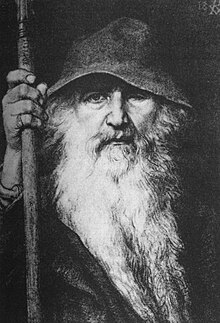
Odin (;[i] from One-time Norse: Óðinn, IPA: [ˈoːðenː]) is a widely revered god in Germanic mythology. Norse mythology, the source of near surviving information virtually him, assembly him with wisdom, healing, death, royalty, the gallows, cognition, war, boxing, victory, sorcery, poetry, frenzy, and the runic alphabet, and depicts him as the husband of the goddess Frigg. In wider Germanic mythology and paganism, the god was known in Old English as Wōden , in Onetime Saxon as Uuôden , in Sometime Dutch equally Wuodan , in Old Frisian equally Wêda , and in Quondam Loftier German equally Wuotan , all ultimately stemming from the Proto-Germanic theonym * Wōđanaz , meaning 'lord of frenzy', or 'leader of the possessed'.
Odin appears as a prominent god throughout the recorded history of Northern Europe, from the Roman occupation of regions of Germania (from c. 2 BCE) through movement of peoples during the Migration Menses (4th to 6th centuries CE) and the Viking Age (8th to 11th centuries CE). In the modern flow the rural folklore of Germanic Europe continued to admit Odin. References to him appear in place names throughout regions historically inhabited by the ancient Germanic peoples, and the solar day of the week Wednesday bears his proper name in many Germanic languages, including in English.
In Old English texts, Odin holds a detail place as a euhemerized ancestral effigy among royalty, and he is often referred to as a founding figure among various other Germanic peoples, such as the Langobards, while some Old Norse sources depict him equally an enthroned ruler of the gods. Forms of his name appear frequently throughout the Germanic record, though narratives regarding Odin are mainly found in Old Norse works recorded in Iceland, primarily effectually the 13th century. These texts make up the bulk of mod understanding of Norse mythology.
Old Norse texts portray Odin as the son of Bestla and Borr along with 2 brothers, Vili and Vé, and he fathered many sons, most famously the gods Thor (with Jörð ) and Baldr (with Frigg ). He is known past hundreds of names. Odin is frequently portrayed as one-eyed and long-bearded, wielding a spear named Gungnir or appearing in disguise wearing a cloak and a broad lid. He is often accompanied past his creature familiars—the wolves Geri and Freki and the ravens Huginn and Muninn, who bring him information from all over Midgard —and he rides the flight, 8-legged steed Sleipnir across the sky and into the underworld. In these texts he frequently seeks greater noesis, almost famously by obtaining the Mead of Verse, and makes wagers with his wife Frigg over his endeavors. He takes function both in the creation of the world past slaying the primordial being Ymir and in giving life to the commencement two humans Ask and Embla. He also provides mankind noesis of runic writing and verse, showing aspects of a culture hero. He has a particular association with the Yule vacation.
Odin is also associated with the divine battlefield maidens, the valkyries, and he oversees Valhalla, where he receives half of those who dice in battle, the einherjar , sending the other half to the goddess Freyja 's Fólkvangr . Odin consults the disembodied, herb-embalmed head of the wise Mímir , who foretells the doom of Ragnarök and urges Odin to lead the einherjar into battle before being consumed past the monstrous wolf Fenrir . In later folklore, Odin sometimes appears every bit a leader of the Wild Hunt, a ghostly procession of the expressionless through the winter sky. He is associated with charms and other forms of magic, especially in Sometime English language and Quondam Norse texts.
The figure of Odin is a frequent subject of interest in Germanic studies, and scholars have avant-garde numerous theories regarding his development. Some of these focus on Odin'south detail relation to other figures; for example, Freyja 's hubby Óðr appears to exist something of an etymological doublet of the god, while Odin's wife Frigg is in many means like to Freyja , and Odin has a particular relation to Loki . Other approaches focus on Odin's identify in the historical record, exploring whether Odin derives from Proto-Indo-European mythology or developed afterwards in Germanic society. In the modern period Odin has inspired numerous works of poetry, music, and other cultural expressions. He is venerated with other Germanic gods in about forms of the new religious movement Heathenry; some branches focus particularly on him.
Name [edit]
Etymology and origin [edit]
The Old Norse theonym Óðinn (runic ᚢᚦᛁᚾ on the Ribe skull fragment)[ii] is a cognate (linguistic sibling of the same origin) of other medieval Germanic names, including Old English language Wōden, One-time Saxon Wōdan, Erstwhile Dutch Wuodan, and Old High German language Wuotan (Sometime Bavarian Wûtan).[3] [4] [five] They all derive from the reconstructed Proto-Germanic masculine theonym *Wōđanaz (or *Wōdunaz).[three] [vi] Translated every bit 'lord of frenzy',[7] or as 'leader of the possessed',[viii] *Wōđanaz stems from the Proto-Germanic adjective *wōđaz ('possessed, inspired, delirious, raging') attached to the suffix *-naz ('master of').[7]

Woðinz (read from right to left), a probably accurate attestation of a pre-Viking Age grade of Odin, on the Strängnäs stone.
Internal and comparative evidence all point to the ideas of a divine possession or inspiration, and an ecstatic divination.[9] [10] In his Gesta Hammaburgensis ecclesiae pontificum (1075–1080 AD), Adam of Bremen explicitly associates Wotan with the Latin term furor, which tin exist translated every bit 'rage', 'fury', 'madness', or 'frenzy' (Wotan id est furor : "Odin, that is, furor").[11] As of 2011, an attestation of Proto-Norse Woðinz, on the Strängnäs stone, has been accepted as probably authentic, simply the name may be used as a related adjective instead pregnant "with a gift for (divine) possession" (ON: øðinn).[12]
Other Germanic cognates derived from *wōđaz include Gothic woþs ('possessed'), Old Norse óðr ('mad, frantic, furious'), Old English wōd ('insane, frenzied') or Dutch woed ('frantic, wild, crazy'), along with the substantivized forms Old Norse óðr ('mind, wit, sense; vocal, poesy'), Old English wōþ ('audio, dissonance; phonation, song'), Old High German wuot ('thrill, violent agitation') and Centre Dutch woet ('rage, frenzy'), where the original adjective turned into a noun. The Proto-Germanic terms *wōđīn ('madness, fury') and *wōđjanan ('to rage') can also be reconstructed.[3] Early epigraphic attestations of the adjective include un-wōdz ('calm one', i.eastward. 'not-furious'; 200 CE) and wōdu-rīde ('furious rider'; 400 CE).[10]
Philologist Jan de Vries has argued that the Old Norse deities Óðinn and Óðr were probably originally connected (equally in the doublet Ullr–Ullinn), with Óðr (*wōđaz) being the elder form and the ultimate source of the proper name Óðinn (*wōđa-naz). He further suggested that the god of rage Óðr–Óðinn stood in opposition to the god of glorious majesty Ullr–Ullinn in a similar fashion to the Vedic contrast between Varuna and Mitra.[xiii]
The adjective *wōđaz ultimately stems from a Pre-Germanic course *uoh₂-tós, which is related to the Proto-Celtic terms *wātis, meaning 'seer, sooth-sayer' (cf. Gaulish wāteis, Old Irish fáith 'prophet') and *wātus, significant 'prophesy, poetic inspiration' (cf. Old Irish fáth 'prophesic wisdom, maxims', Old Welsh guaut 'prophetic verse, panegyric').[9] [10] [14] According to some scholars, the Latin term vātēs ('prophet, seer') is probably a Celtic loanword from the Gaulish language, making *uoh₂-tós ~ *ueh₂-tus ('god-inspired') a shared religious term mutual to Germanic and Celtic rather than an inherited give-and-take of earlier Proto-Indo-European (PIE) origin.[9] [10] In the instance a borrowing scenario is excluded, a PIE etymon *(H)ueh₂-tis ('prophet, seer') can also be posited equally the mutual ancestor of the attested Germanic, Celtic and Latin forms.[six]
Other names [edit]
More than 170 names are recorded for Odin; the names are variously descriptive of attributes of the god, refer to myths involving him, or refer to religious practices associated with him. This multitude makes Odin the god with the nigh known names amid the Germanic peoples.[xv] Prof Steve Martin has pointed out that the proper noun Odinsberg (Ounesberry, Ounsberry, Othenburgh)[16] in Cleveland Yorkshire, now corrupted to Roseberry (Topping), may derive from the fourth dimension of the Anglian settlements, with nearby Newton under Roseberry and Great Ayton[17] having Anglo Saxon suffixes. The very dramatic rocky superlative was an obvious identify for divine association, and may have replaced statuary age/fe age beliefs of divinity there, given that a hoard of bronze votive axes and other objects was buried by the height.[18] [xix] It could be a rare instance, then, of Nordic-Germanic theology displacing earlier Celtic mythology in an imposing place of tribal prominence.
In his opera cycle Der Ring des Nibelungen, Richard Wagner refers to the god equally Wotan, a spelling of his own invention which combines the Old High German Wuotan with the Low High german Wodan.[20]
Origin of Wednesday [edit]
The modern English weekday proper noun Wed derives from Former English Wōdnesdæg, meaning 'twenty-four hours of Wōden'. Cognate terms are found in other Germanic languages, such equally Middle Low German language and Center Dutch Wōdensdach (mod Dutch woensdag), Old Frisian Wērnisdei (≈ Wērendei) and Onetime Norse Óðinsdagr (cf. Danish, Norwegian, Swedish onsdag). All of these terms derive from Late Proto-Germanic *Wodanesdag ('Solar day of Wōđanaz'), a calque of Latin Mercurii dies ('Day of Mercury'; cf. modern Italian mercoledì, French mercredi, Castilian miércoles).[21] [22]
Attestations [edit]
Roman era to Migration Catamenia [edit]

I of the Torslunda plates. The figure to the left was cast with both eyes, only subsequently the correct eye was removed.[23]
The earliest records of the Germanic peoples were recorded by the Romans, and in these works Odin is frequently referred to—via a procedure known as interpretatio romana (where characteristics perceived to exist similar by Romans result in identification of a non-Roman god as a Roman deity)—as the Roman god Mercury. The outset clear example of this occurs in the Roman historian Tacitus'due south late 1st-century work Germania , where, writing nearly the religion of the Suebi (a confederation of Germanic peoples), he comments that "among the gods Mercury is the ane they principally worship. They regard it as a religious duty to offer to him, on fixed days, human being as well as other sacrificial victims. Hercules and Mars they gratify by animal offerings of the permitted kind" and adds that a portion of the Suebi also venerate "Isis". In this instance, Tacitus refers to the god Odin as "Mercury", Thor as "Hercules", and Týr equally "Mars". The "Isis" of the Suebi has been debated and may represent "Freyja".[24]
Anthony Birley noted that Odin's apparent identification with Mercury has little to do with Mercury's classical office of existence messenger of the gods, simply appears to be due to Mercury's part of psychopomp.[24] Other contemporary prove may also have led to the equation of Odin with Mercury; Odin, similar Mercury, may accept at this time already been pictured with a staff and hat, may accept been considered a trader god, and the ii may have been seen as parallel in their roles equally wandering deities. But their rankings in their respective religious spheres may have been very unlike.[25] Also, Tacitus's "amid the gods Mercury is the i they principally worship" is an exact quote from Julius Caesar's Commentarii de Bello Gallico (1st century BCE) in which Caesar is referring to the Gauls and not the Germanic peoples. Regarding the Germanic peoples, Caesar states: "[T]hey consider the gods only the ones that they can see, the Dominicus, Burn down and the Moon", which scholars refuse as clearly mistaken, regardless of what may have led to the statement.[24]
In that location is no direct, undisputed evidence for the worship of Odin/Mercury among the Goths, and the existence of a cult of Odin among them is debated.[26] Richard North and Herwig Wolfram have both argued that the Goths did not worship Odin. Wolfram argued that the apply of Greek names of the calendar week in Gothic showed that they did not worship Odin.[27] One possible reading of the Gothic Band of Pietroassa is that the inscription "gutaniowi hailag" means "sacred to Wodan-Jove", but this is highly disputed.[26]
Although the English kingdoms were converted to Christianity by the 7th century, Odin is oftentimes listed equally a founding figure amidst the Old English language royalty.[28]
Odin is likewise either directly or indirectly mentioned a few times in the surviving Old English poetic corpus, including the 9 Herbs Amuse and probable too the Old English rune poem. Odin may also be referenced in the riddle Solomon and Saturn. In the Nine Herbs Amuse, Odin is said to have slain a wyrm (serpent, European dragon) past way of nine "celebrity twigs". Preserved from an 11th-century manuscript, the poem is, co-ordinate to Pecker Griffiths, "one of the most enigmatic of Old English texts". The section that mentions Odin is equally follows:
| + wyrm com snican, toslat he nan, | A serpent came itch (but) it destroyed no one |
| —Bill Griffiths translation |
The emendation of nan to 'human being' has been proposed. The side by side stanza comments on the creation of the herbs chervil and fennel while hanging in sky by the 'wise lord' ( witig drihten ) and before sending them down among mankind. Regarding this, Griffith comments that "In a Christian context 'hanging in heaven' would refer to the crucifixion; but (remembering that Woden was mentioned a few lines previously) there is also a parallel, mayhap a better one, with Odin, as his crucifixion was associated with learning."[29] The Old English language gnomic poem Maxims I besides mentions Odin by proper noun in the (alliterative) phrase Woden worhte weos , ('Woden made idols'), in which he is contrasted with and denounced confronting the Christian God.[xxx]

The Old English rune ós , which is described in the Onetime English rune verse form
The Old English language rune poem recounts the Old English language runic alphabet, the futhorc. The stanza for the rune ós reads every bit follows:
| ōs byþ ordfruma ǣlcre sprǣce | god is the origin of all language |
| —Stephen Pollington |
The first word of this stanza, ōs (Latin 'oral fissure') is a homophone for Onetime English bone , a particularly heathen word for 'god'. Due to this and the content of the stanzas, several scholars have posited that this poem is censored, having originally referred to Odin.[32] Kathleen Herbert comments that " Bone was cognate with As in Norse, where it meant one of the Æsir , the principal family of gods. In Erstwhile English, it could exist used equally an element in first names: Osric, Oswald, Osmund, etc. but it was not used equally a word to refer to the God of Christians. Woden was equated with Mercury, the god of eloquence (among other things). The tales well-nigh the Norse god Odin tell how he gave ane of his optics in return for wisdom; he too won the mead of poetic inspiration. Luckily for Christian rune-masters, the Latin word os could be substituted without ruining the sense, to continue the outward class of the rune name without plain referring to Woden."[33]
In the prose narrative of Solomon and Saturn, "Mercurius the Giant" ( Mercurius se gygand ) is referred to every bit an inventor of messages. This may likewise be a reference to Odin, who is in Norse mythology the founder of the runic alphabets, and the gloss a continuation of the practice of equating Odin with Mercury found as early as Tacitus.[34] One of the Solomon and Saturn poems is additionally in the style of later One-time Norse material featuring Odin, such as the Old Norse poem Vafþrúðnismál , featuring Odin and the jötunn Vafþrúðnir engaging in a deadly game of wits.[35]
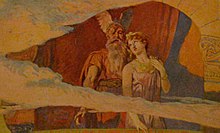
Wodan and Frea expect down from their window in the heavens to the Winnili women in an illustration past Emil Doepler, 1905
![]()
Winnili women with their hair tied as beards wait up at Godan and Frea in an analogy past Emil Doepler, 1905
The 7th-century Origo Gentis Langobardorum , and Paul the Deacon's eighth-century Historia Langobardorum derived from information technology, recount a founding myth of the Langobards (Lombards), a Germanic people who ruled a region of the Italian Peninsula. According to this legend, a "modest people" known equally the Winnili were ruled past a woman named Gambara who had two sons, Ybor and Aio. The Vandals, ruled by Ambri and Assi, came to the Winnili with their army and demanded that they pay them tribute or prepare for state of war. Ybor, Aio, and their mother Gambara rejected their demands for tribute. Ambri and Assi and then asked the god Godan for victory over the Winnili, to which Godan responded (in the longer version in the Origo ): "Whom I shall first see when at sunrise, to them volition I give the victory."[36]
Meanwhile, Ybor and Aio called upon Frea, Godan's wife. Frea counselled them that "at sunrise the Winnil[i] should come, and that their women, with their hair let down around the face in the likeness of a beard should also come with their husbands". At sunrise, Frea turned Godan'south bed effectually to face east and woke him. Godan saw the Winnili and their whiskered women and asked, "who are those Long-beards?" Frea responded to Godan, "Every bit you lot have given them a name, requite them also the victory". Godan did and so, "so that they should defend themselves according to his counsel and obtain the victory". Thenceforth the Winnili were known as the Langobards ('long-beards').[37]
Writing in the mid-7th century, Jonas of Bobbio wrote that earlier that century the Irish missionary Columbanus disrupted an offer of beer to Odin (vodano) "(whom others called Mercury)" in Swabia.[38] A few centuries later, 9th-century document from what is now Mainz, Germany, known as the Old Saxon Baptismal Vow records the names of three Sometime Saxon gods, UUôden ('Woden'), Saxnôte , and Thunaer ('Thor'), whom heathen converts were to renounce as demons.[39]
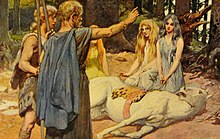
Wodan Heals Balder's Horse by Emil Doepler, 1905
A 10th-century manuscript found in Merseburg, Germany, features a heathen invocation known every bit the Second Merseburg Incantation, which calls upon Odin and other gods and goddesses from the continental Germanic pantheon to help in healing a horse:
| Phol ende uuodan uuoran zi holza. | Phol and Woden travelled to the forest. |
| —Pecker Griffiths translation |
Viking Age to post-Viking Age [edit]

A 16th-century depiction of Norse gods by Olaus Magnus: from left to right, Frigg, Odin, and Thor
In the 11th century, chronicler Adam of Bremen recorded in a scholion of his Gesta Hammaburgensis Ecclesiae Pontificum that a statue of Thor, whom Adam describes every bit "mightiest", sat enthroned in the Temple at Uppsala (located in Gamla Uppsala, Sweden) flanked past Wodan (Odin) and "Fricco". Regarding Odin, Adam defines him as "frenzy" ( Wodan, id est furor ) and says that he "rules state of war and gives people strength confronting the enemy" and that the people of the temple describe him as wearing armour, "equally our people depict Mars". According to Adam, the people of Uppsala had appointed priests (gothi) to each of the gods, who were to offer up sacrifices (blót), and in times of war sacrifices were made to images of Odin.[eleven]
In the twelfth century, centuries later on Kingdom of norway was "officially" Christianised, Odin was still being invoked by the population, as evidenced by a stick bearing a runic message found among the Bryggen inscriptions in Bergen, Kingdom of norway. On the stick, both Thor and Odin are chosen upon for help; Thor is asked to "receive" the reader, and Odin to "own" them.[41]
Poetic Edda [edit]
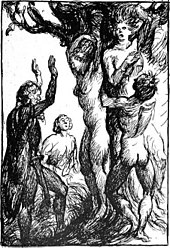
The trio of gods giving the beginning humans, Ask and Embla, by Robert Engels, 1919
Odin is mentioned or appears in about poems of the Poetic Edda, compiled in the 13th century from traditional source cloth reaching back to the pagan menstruum.
The poem Völuspá features Odin in a dialogue with an undead völva, who gives him wisdom from ages by and foretells the onset of Ragnarök , the destruction and rebirth of the world. Amongst the information the völva recounts is the story of the offset human beings (Ask and Embla), plant and given life by a trio of gods; Odin, Hœnir , and Lóðurr : In stanza 17 of the Poetic Edda verse form Völuspá , the völva reciting the poem states that Hœnir , Lóðurr and Odin once establish Enquire and Embla on land. The völva says that the two were capable of very trivial, lacking in ørlög and says that they were given three gifts by the three gods:
- Ǫnd þau né átto, óð þau né hǫfðo,
- lá né læti né lito góða.
- Ǫnd gaf Óðinn, óð gaf Hœnir,
- lá gaf Lóðurr ok lito góða.
- Old Norse: [42]
- Spirit they possessed not, sense they had not,
- blood nor motive powers, nor goodly colour.
- Spirit gave Odin , sense gave Hœnir ,
- blood gave Lodur , and goodly colour.
- Benjamin Thorpe translation: [43]
- Soul they had not, sense they had not,
- Heat nor motion, nor goodly hue;
- Soul gave Othin , sense gave Hönir ,
- Heat gave Lothur and goodly hue.
- Henry Adams Bellows translation: [44]
The meaning of these gifts has been a matter of scholarly disagreement and translations therefore vary.[45]
Afterwards in the poem, the völva recounts the events of the Æsir–Vanir War, the war between Vanir and the Æsir , 2 groups of gods. During this, the first war of the earth, Odin flung his spear into the opposing forces of the Vanir .[46] The völva tells Odin that she knows where he has subconscious his eye; in the jump Mímisbrunnr , and from it " Mímir drinks mead every morning".[47] Afterwards Odin gives her necklaces, she continues to recount more data, including a list of valkyries, referred to as nǫnnor Herians 'the ladies of War Lord'; in other words, the ladies of Odin.[48] In foretelling the events of Ragnarök , the völva predicts the decease of Odin; Odin will fight the monstrous wolf Fenrir during the great battle at Ragnarök . Odin will be consumed by the wolf, yet Odin's son Víðarr will avenge him by stabbing the wolf in the heart.[49] Later the world is burned and renewed, the surviving and returning gods volition run into and recall Odin's deeds and "ancient runes".[l]
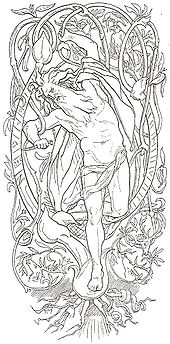
Odin sacrificing himself upon Yggdrasil as depicted by Lorenz Frølich , 1895
The poem Hávamál (Onetime Norse 'Sayings of the High One') consists entirely of wisdom poesy attributed to Odin. This advice ranges from the practical ("A man shouldn't concur onto the cup but drink in moderation, it's necessary to speak or be silent; no man will blame you lot for impoliteness if y'all go early to bed"), to the mythological (such as Odin'due south recounting of his retrieval of Óðrœrir , the vessel containing the mead of poetry), and to the mystical (the final section of the verse form consists of Odin's recollection of xviii charms).[51] Amidst the various scenes that Odin recounts is his self-cede:
|
|
|
While the name of the tree is not provided in the poem and other trees be in Norse mythology, the tree is near universally accustomed every bit the cosmic tree Yggdrasil , and if the tree is Yggdrasil , then the proper noun Yggdrasil (Old Norse 'Ygg's steed') straight relates to this story. Odin is associated with hanging and gallows; John Lindow comments that "the hanged 'ride' the gallows".[55]
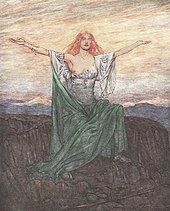
After beingness put to slumber by Odin and beingness awoken by the hero Sigurd , the valkyrie Sigrífa says a heathen prayer; illustration (1911) past Arthur Rackham
In the prose introduction to the poem Sigrdrífumál , the hero Sigurd rides upwards to Hindarfell and heads south towards "the state of the Franks". On the mount Sigurd sees a great light, "as if fire were called-for, which blazed up to the sky". Sigurd approaches information technology, and there he sees a skjaldborg (a tactical germination of shield wall) with a banner flying overhead. Sigurd enters the skjaldborg , and sees a warrior lying there—comatose and fully armed. Sigurd removes the helmet of the warrior, and sees the confront of a woman. The adult female's corslet is and so tight that it seems to take grown into the woman's body. Sigurd uses his sword Gram to cutting the corslet, starting from the neck of the corslet downwards, he continues cutting downwards her sleeves, and takes the corslet off her.[56]
The woman wakes, sits up, looks at Sigurd , and the two converse in two stanzas of verse. In the 2nd stanza, the woman explains that Odin placed a sleeping spell on her which she could not suspension, and due to that spell she has been asleep a long fourth dimension. Sigurd asks for her proper name, and the woman gives Sigurd a horn of mead to help him retain her words in his retentivity. The woman recites a infidel prayer in two stanzas. A prose narrative explains that the woman is named Sigrdrífa and that she is a valkyrie.[57]
A narrative relates that Sigrdrífa explains to Sigurd that there were two kings fighting 1 another. Odin had promised 1 of these— Hjalmgunnar —victory in battle, notwithstanding she had "brought down" Hjalmgunnar in battle. Odin pricked her with a sleeping-thorn in consequence, told her that she would never once again "fight victoriously in battle", and condemned her to matrimony. In response, Sigrdrífa told Odin she had sworn a great adjuration that she would never wed a human being who knew fear. Sigurd asks Sigrdrífa to share with him her wisdom of all worlds. The poem continues in verse, where Sigrdrífa provides Sigurd with cognition in inscribing runes, mystic wisdom, and prophecy.[58]
Prose Edda [edit]
Odin is mentioned throughout the books of the Prose Edda, composed in the 13th century and drawing from before traditional textile. The god is introduced at length in chapter nine of the Prose Edda volume Gylfaginning, which explains that he is described as ruling over Asgard, the domain of the gods, on his throne, that he is the 'male parent of all', and that from him all the gods, all of humankind (by way of Ask and Embla), and everything else he has made or produced. According to Gylfaginning, in Asgard:
- There the gods and their descendants lived and there took place equally a outcome many developments both on globe and aloft. In the city there is a seat called Hlidskialf, and when Odin saturday in that throne he saw over all words and every human'southward activeness and understood everything he saw. His wife was called Frigg Fiorgvin's daughter, and from them is descended the family unit line that we call the Æsir race, who have resided in Sometime Asgard and the realms that belong to it, and that whole line of descent is of divine origin. And this is why he can be called All-father, that he is begetter of all gods and of men and of everything that has been brought into being by him and his ability. The world was his daughter and his wife. Out of her he begot the first of his ons, that is Asa-Thor.[59]
In the Prose Edda book Gylfaginning (affiliate 38), the enthroned effigy of High (Harr), tells Gangleri (king Gylfi in disguise) that 2 ravens named Huginn and Muninn sit on Odin's shoulders. The ravens tell Odin everything they encounter and hear. Odin sends Huginn and Muninn out at dawn, and the birds wing all over the world earlier returning at dinner-fourth dimension. As a result, Odin is kept informed of many events. High adds that it is from this association that Odin is referred to equally "raven-god". The above-mentioned stanza from Grímnismál is then quoted.[60]
In the same affiliate, the enthroned effigy of High explains that Odin gives all of the food on his table to his wolves Geri and Freki and that Odin requires no food, for wine is to him both meat and drink.[60]
Heimskringla and sagas [edit]

Óðinn throws his spear at the Vanir host in an illustration by Lorenz Frølich (1895)
Odin is mentioned several times in the sagas that brand upwardly Heimskringla . In the Ynglinga saga , the beginning section of Heimskringla , an euhemerised business relationship of the origin of the gods is provided. Odin is introduced in chapter two, where he is said to take lived in "the country or dwelling house of the Æsir " (Old Norse: Ásaland eða Ásaheimr), the capital of which being Ásgarðr . Ásgarðr was ruled by Odin, a great chieftain, and was "a great identify for sacrifices". It was the custom there that twelve temple priests were ranked highest; they administered sacrifices and held judgements over men. "Called diar or chiefs", the people were obliged to serve under them and respect them. Odin was a very successful warrior and travelled widely, conquering many lands. Odin was so successful that he never lost a boxing. As a outcome, co-ordinate to the saga, men came to believe that "it was granted to him" to win all battles. Before Odin sent his men to war or to perform tasks for him, he would identify his hands upon their heads and give them a bjannak ('blessing', ultimately from Latin benedictio ) and the men would believe that they would also prevail. The men placed all of their faith in Odin, and wherever they called his proper name they would receive help from doing so. Odin was frequently gone for keen spans of fourth dimension.[61]
Chapter iii says that Odin had 2 brothers, Vé and Vili. While Odin was gone, his brothers governed his realm. In one case, Odin was gone for so long that the Æsir believed that he would not return. His brothers began to divvy up Odin's inheritance, "but his wife Frigg they shared between them. However, afterwards, [Odin] returned and took possession of his wife again".[61] Chapter four describes the Æsir–Vanir State of war. According to the chapter, Odin "fabricated war on the Vanir ". The Vanir defended their land and the boxing turned to a stalemate, both sides having devastated each other'southward lands. As part of a peace agreement, the two sides exchanged hostages. One of the exchanges went amiss and resulted in the Vanir decapitating ane of the hostages sent to them by the Æsir , Mímir . The Vanir sent Mímir 's head to the Æsir , whereupon Odin "took it and embalmed it with herbs so that information technology would not rot, and spoke charms [Onetime Norse galdr ] over it", which imbued the caput with the ability to respond Odin and "tell him many occult things".[62]
In Völsunga saga , the great king Rerir and his married woman (unnamed) are unable to conceive a child; "that lack displeased them both, and they fervently implored the gods that they might accept a child. Information technology is said that Frigg heard their prayers and told Odin what they asked", and the two gods subsequently sent a Valkyrie to present Rerir an apple that falls onto his lap while he sits on a burial mound and Rerir 's wife subsequently becomes pregnant with the namesake of the Völsung family line.[63]
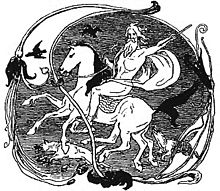
In the 13th century legendary saga Hervarar saga ok Heiðreks , the verse form Heiðreks gátur contains a riddle that mentions Sleipnir and Odin:
36. Gestumblindi said:
- Who are the twain
- that on ten feet run?
- iii eyes they have,
- but only ane tail.
- All correct guess now
- this riddle, Heithrek !
Heithrek said:
- Good is thy riddle, Gestumblindi ,
- and guessed it is:
- that is Odin riding on Sleipnir .[64]
Modern folklore [edit]
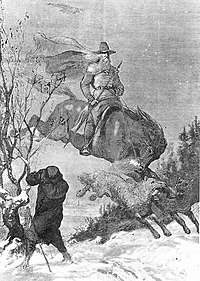
Local folklore and folk exercise recognised Odin as late every bit the 19th century in Scandinavia. In a work published in the mid-19th century, Benjamin Thorpe records that on Gotland, "many traditions and stories of Odin the Former all the same live in the mouths of the people". Thorpe notes that, in Blekinge in Sweden, "it was formerly the custom to leave a sheaf on the field for Odin'south horses", and cites other examples, such equally in Kråktorpsgård , Småland , where a barrow was purported to have been opened in the 18th century, purportedly containing the body of Odin. Afterward Christianization, the mound was known equally Helvetesbackke (Swedish "Hell's Mound"). Local fable dictates that after it was opened, "in that location burst along a wondrous fire, like a flash of lightning", and that a coffin full of flint and a lamp were excavated. Thorpe additionally relates that fable has it that a priest who dwelt around Troienborg had once sowed some rye, and that when the rye sprang upwards, so came Odin riding from the hills each evening. Odin was so massive that he towered over the farm-1000 buildings, spear in manus. Halting earlier the entry way, he kept all from entering or leaving all dark, which occurred every dark until the rye was cutting.[65]
Thorpe relates that "a story is also current of a gold ship, which is said to be sunk in Runemad , near the Nyckelberg , in which, co-ordinate to tradition, Odin fetched the slain from the boxing of Bråvalla to Valhall ", and that Kettilsås , co-ordinate to legend, derives its name from "one Ketill Runske , who stole Odin'south runic staves" ( runekaflar ) and and so bound Odin'due south dogs, bull, and a mermaid who came to assistance Odin. Thorpe notes that numerous other traditions existed in Sweden at the time of his writing.[66]
Thorpe records (1851) that in Sweden, "when a noise, similar that of carriages and horses, is heard by dark, the people say: 'Odin is passing past'".[67]
Odin and the gods Loki and Hœnir assist a farmer and a boy escape the wrath of a bet-winning jötunn in Loka Táttur or Lokka Táttur , a Faroese ballad dating to the Belatedly Middle Ages.[68]
Archaeological record [edit]
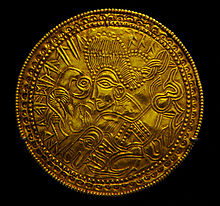
A C-type bracteate (DR BR42) featuring a figure above a horse flanked by a bird
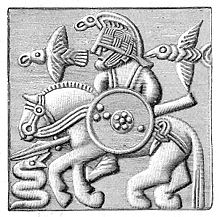
A plate from a Swedish Vendel era helmet featuring a figure riding a horse, accompanied by ii ravens, property a spear and shield, and confronted by a snake
References to or depictions of Odin announced on numerous objects. Migration Catamenia (5th and 6th century CE) gold bracteates (types A, B, and C) characteristic a delineation of a human figure above a equus caballus, belongings a spear and flanked by one or more frequently two birds. The presence of the birds has led to the iconographic identification of the human figure as the god Odin, flanked by Huginn and Muninn . Like the Prose Edda clarification of the ravens, a bird is sometimes depicted at the ear of the homo, or at the ear of the horse. Bracteates take been institute in Denmark, Sweden, Norway and, in smaller numbers, England and areas s of Denmark.[69] Austrian Germanist Rudolf Simek states that these bracteates may depict Odin and his ravens healing a horse and may indicate that the birds were originally not simply his battlefield companions just likewise "Odin'south helpers in his veterinary function."[seventy]
Vendel Period helmet plates (from the 6th or seventh century) found in a grave in Sweden depict a helmeted figure holding a spear and a shield while riding a horse, flanked past two birds. The plate has been interpreted equally Odin accompanied by two birds; his ravens.[71]
Ii of the 8th century pic stones from the island of Gotland, Sweden draw 8-legged horses, which are thought by most scholars to depict Sleipnir : the Tjängvide image stone and the Ardre Eight image stone. Both stones feature a passenger sitting atop an eight-legged equus caballus, which some scholars view as Odin. Above the rider on the Tjängvide image stone is a horizontal figure holding a spear, which may be a valkyrie, and a female figure greets the passenger with a cup. The scene has been interpreted as a rider arriving at the earth of the expressionless.[72] The mid-7th century Eggja stone begetting the Odinic proper noun haras (Old Norse 'army god') may be interpreted as depicting Sleipnir .[73]
A pair of identical Germanic Iron Historic period bird-shaped brooches from Bejsebakke in northern Denmark may be depictions of Huginn and Muninn . The dorsum of each bird features a mask-motif, and the feet of the birds are shaped like the heads of animals. The feathers of the birds are also composed of animal-heads. Together, the animal-heads on the feathers grade a mask on the back of the bird. The birds have powerful beaks and fan-shaped tails, indicating that they are ravens. The brooches were intended to be worn on each shoulder, after Germanic Iron Age fashion.[74] Archaeologist Peter Vang Petersen comments that while the symbolism of the brooches is open to debate, the shape of the beaks and tail feathers confirms the brooch depictions are ravens. Petersen notes that "raven-shaped ornaments worn equally a pair, after the mode of the day, one on each shoulder, makes one's thoughts plow towards Odin's ravens and the cult of Odin in the Germanic Iron Historic period." Petersen says that Odin is associated with disguise, and that the masks on the ravens may be portraits of Odin.[74]
The Oseberg tapestry fragments, discovered inside the Viking Age Oseberg transport burying in Norway, features a scene containing two black birds hovering over a horse, possibly originally leading a wagon (equally a part of a procession of horse-led wagons on the tapestry). In her examination of the tapestry, scholar Anne Stine Ingstad interprets these birds as Huginn and Muninn flying over a covered cart containing an image of Odin, cartoon comparison to the images of Nerthus attested by Tacitus in 1 CE.[75]
Excavations in Ribe, Denmark accept recovered a Viking Historic period atomic number 82 metallic-caster'south mould and 11 identical casting-moulds. These objects depict a moustached man wearing a helmet that features ii head-ornaments. Archeologist Stig Jensen proposes these head-ornaments should be interpreted as Huginn and Muninn, and the wearer as Odin. He notes that "similar depictions occur everywhere the Vikings went—from eastern England to Russian federation and naturally likewise in the rest of Scandinavia."[76]
A portion of Thorwald's Cross (a partly surviving runestone erected at Kirk Andreas on the Isle of Man) depicts a bearded homo holding a spear downward at a wolf, his right foot in its oral fissure, and a big bird on his shoulder.[77] Andy Orchard comments that this bird may be either Huginn or Muninn .[78] Rundata dates the cross to 940,[79] while Pluskowski dates information technology to the 11th century.[77] This depiction has been interpreted as Odin, with a raven or eagle at his shoulder, being consumed by the monstrous wolf Fenrir during the events of Ragnarök .[77] [80]
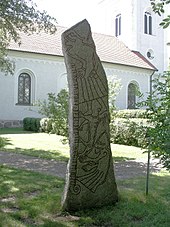
The 11th century Ledberg stone in Sweden, similarly to Thorwald's Cross, features a figure with his human foot at the oral cavity of a iv-legged beast, and this may also be a depiction of Odin being devoured by Fenrir at Ragnarök .[80] Below the beast and the man is a depiction of a legless, helmeted man, with his arms in a prostrate position.[80] The Younger Futhark inscription on the stone bears a commonly seen memorial dedication, merely is followed by an encoded runic sequence that has been described as "mysterious,"[81] and "an interesting magic formula which is known from all over the ancient Norse earth."[80]
In November 2009, the Roskilde Museum announced the discovery and subsequent display of a niello-inlaid argent figurine establish in Lejre , which they dubbed Odin from Lejre. The silver object depicts a person sitting on a throne. The throne features the heads of animals and is flanked past 2 birds. The Roskilde Museum identifies the effigy as Odin sitting on his throne Hliðskjálf , flanked past the ravens Huginn and Muninn.[82]
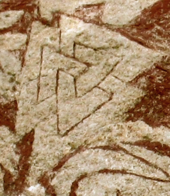
Various interpretations have been offered for a symbol that appears on diverse archaeological finds known modernly as the valknut . Due to the context of its placement on some objects, some scholars have interpreted this symbol as referring to Odin. For instance, Hilda Ellis Davidson theorises a connection between the valknut , the god Odin and "mental binds":
For instance, abreast the figure of Odin on his horse shown on several memorial stones in that location is a kind of knot depicted, called the valknut , related to the triskele. This is thought to symbolize the power of the god to bind and unbind, mentioned in the poems and elsewhere. Odin had the power to lay bonds upon the mind, so that men became helpless in boxing, and he could also loosen the tensions of fright and strain by his gifts of battle-madness, intoxication, and inspiration.[83]
Davidson says that similar symbols are found beside figures of wolves and ravens on "certain cremation urns" from Anglo-Saxon cemeteries in East Anglia. Co-ordinate to Davidson, Odin's connectedness to cremation is known, and information technology does not seem unreasonable to connect with Odin in Anglo-Saxon England. Davidson proposes further connections between Odin's part equally bringer of ecstasy past style of the etymology of the god'southward proper name.[83]
Origin, theories, and reception [edit]
Beginning with Henry Petersen's doctoral dissertation in 1876, which proposed that Thor was the indigenous god of Scandinavian farmers and Odin a subsequently god proper to chieftains and poets, many scholars of Norse mythology in the past viewed Odin as having been imported from elsewhere. The thought was developed by Bernhard Salin on the basis of motifs in the petroglyphs and bracteates, and with reference to the Prologue of the Prose Edda, which presents the Æsir as having migrated into Scandinavia. Salin proposed that both Odin and the runes were introduced from Southeastern Europe in the Iron Historic period. Other scholars placed his introduction at unlike times; Axel Olrik, during the Migration Historic period as a result of Gaulish influence.[84]
More than radically, both the archaeologist and comparative mythologist Marija Gimbutas and the Germanicist Karl Captain argued that the Æsir as a group, which includes both Thor and Odin, were late introductions into Northern Europe and that the ethnic religion of the region had been Vanic .[85] [86]
In the 16th century and by the entire Vasa dynasty, Odin (as Oden ) was officially considered the get-go King of Sweden by that state'southward authorities and historians. This was based on an embellished listing of rulers invented past Johannes Magnus and officially adopted in the reign of King Carl IX, who, though numbered appropriately, actually was just the tertiary Swedish rex of that name.[87]
Under the trifunctional hypothesis of Georges Dumézil, Odin is assigned one of the core functions in the Indo-European pantheon equally a representative of the showtime office (sovereignty) corresponding to the Hindu Varuṇa (fury and magic) as opposed to Týr , who corresponds to the Hindu Mitrá (law and justice); while the Vanir represent the 3rd function (fertility).[88] [89]
Some other arroyo to Odin has been in terms of his role and attributes. Many early scholars interpreted him as a wind-god or especially equally a death-god.[ninety] He has also been interpreted in the light of his association with ecstatic practices, and January de Vries compared him to the Hindu god Rudra and the Greek Hermes.[91]
Modernistic influence [edit]

The god Odin has been a source of inspiration for artists working in fine art, literature, and music. Fine fine art depictions of Odin in the modern period include the pen and ink cartoon Odin byggande Sigtuna (1812) and the sketch King Gylfe receives Oden on his arrival to Sweden (1816) by Pehr Hörberg ; the drinking horn relief Odens möte med Gylfe (1818), the marble statue Odin (1830) and the colossal bust Odin past Bengt Erland Fogelberg , the statues Odin (1812/1822) and Odin (1824/1825) by Hermann Ernst Freund , the sgraffito over the entrance of Villa Wahnfried in Bayreuth (1874) by R. Krausse , the painting Odin (around 1880) past Edward Burne-Jones, the drawing Thor und Magni (1883) past K. Ehrenberg , the marble statue Wodan (around 1887) by H. Natter, the oil painting Odin und Brunhilde (1890) by Konrad Dielitz , the graphic drawing Odin als Kriegsgott (1896) by Hans Thoma , the painting Odin and Fenris (effectually 1900) past Dorothy Hardy, the oil painting Wotan und Brünhilde (1914) by Koloman Moser , the painting The Road to Walhall past Due south. Nilsson , the wooden Oslo City Hall relief Odin og Mime (1938) and the coloured wooden relief in the courtyard of the Oslo Urban center Hall Odin på Sleipnir (1945–1950) by Dagfin Werenskiold , and the bronze relief on the doors of the Swedish Museum of National Antiquities, Odin (1950) past Bror Marklund .[92]
Works of modern literature featuring Odin include the poem Der Wein (1745) by Friedrich von Hagedorn , Hymne de Wodan (1769) by Friedrich Gottlieb Klopstock , Om Odin (1771) by Peter Frederik Suhm , the tragedy Odin eller Asarnes invandring by Chiliad. Yard. Leopold , the epic verse form Odin eller Danrigets Stiftelse (1803) by Jens Baggesen, the verse form Maskeradenball (1803) and Optrin af Norners og Asers Kamp: Odin komme til Norden (1809) by N. F. S. Grundtvig , poems in Nordens Guder (1819) by Adam Oehlenschläger , the iv-function novel Sviavigamal (1833) by Carl Jonas Love Almqvist , the poem Prelude (1850) by William Wordsworth, the verse form Odins Meeresritt by Aloys Schreiber set to music by Karl Loewe (1851), the canzone Germanenzug (1864) by Robert Hamerling , the poem Zum 25. August 1870 (1870) by Richard Wagner, the carol Rolf Krake (1910) past F. Schanz, the novel Juvikingerne (1918–1923) past Olav Duun , the comedy Der entfesselte Wotan (1923) by Ernst Toller , the novel Wotan by Karl Hans Strobl , Herrn Wodes Ausfahrt (1937) by Hans-Friedrich Blunck , the poem An das Ich (1938) by H. Burte , and the novel Sage vom Reich (1941–1942) by Hans-Friedrich Blunck .[93]
Music inspired past or featuring the god includes the ballets Odins Schwert (1818) and Orfa (1852) by J. H. Stunz and the opera cycle Der Ring des Nibelungen (1848–1874) by Richard Wagner.[94]
Robert E. Howard'southward story "The Cairn on the Headland" assumes that Odin was a malevolent demonic spirit, that he was mortally wounded when taking man course and fighting amongst the Vikings in the Boxing of Clontarf (1014), that lay asleep for almost a yard years—to wake upward, nearly crusade smashing havoc in mod Dublin merely beingness exorcised by the story'due south protagonist helped past the ghost of a Cosmic saint.
Science Fiction writer Poul Anderson'south story The Sorrow of Odin the Goth asserts that Odin was in fact a twentieth-century American time traveler, who sought to study the culture of the aboriginal Goths and ended up being regarded as a god and starting an indelible myth.
Odin was adapted as a character by Marvel Comics, first appearing in the Journey into Mystery series in 1962.[95] Sir Anthony Hopkins portrayed the graphic symbol in the Marvel Cinematic Universe films Thor (2011), Thor: The Dark World (2013), and Thor: Ragnarok (2017).
Odin is featured in a number of video games. In the 2002 Ensemble Studios game Age of Mythology, Odin is one of three major gods Norse players can worship.[96] [97] [98] Odin is also mentioned through Santa Monica Studio's 2018 game God of State of war and will appear in its 2022 sequel God of War Ragnarök, voiced by Richard Schiff.[99] Odin is also a major influence in the 2020 Ubisoft game Assassin's Creed Valhalla in the form of an Isu (a godlike, humanoid species inside the Assassin's Creed universe) of the same proper name. The main protagonist, Eivor, who the player controls throughout the game is revealed to be a sage, or human reincarnation, of Odin.[100] Odin is too one of the playable gods in the third-person multiplayer online battle arena game Smite.[101]
References [edit]
- ^ "Odin". Random House Webster'south Unabridged Dictionary.
- ^ Schulte, Michael (2006), "The transformation of the older fuþark: Number magic, runographic or linguistic principles?", Arkiv för nordisk filologi, vol. 121, pp. 41–74
- ^ a b c de Vries 1962, p. 416; Orel 2003, p. 469; Kroonen 2013, p. 592
- ^ Ernst Anton Quitzmann, Die heidnische Religion der Baiwaren, ISBN 978-5877606241, 1901
- ^ W.J.J. Pijnenburg (1980), Bijdrage tot de etymologie van het oudste Nederlands, Eindhoven, hoofdstuk vii 'Dinsdag – Woensdag'
- ^ a b de Vaan, Michiel (2018). Etymological Dictionary of Latin and the other Italic Languages. Brill. p. 656. ISBN978-ninety-04-16797-i.
- ^ a b West 2007, p. 137.
- ^ Lindow 2001, p. 28.
- ^ a b c Kroonen 2013, p. 592.
- ^ a b c d Koch 2020, p. 140.
- ^ a b Orchard (1997:168–69).
- ^ Gustavsson, Helmer & Swantesson, January O.H. 2011. Strängnäs, Skramle och Tomteboda: tre urnordiska runinskrifter, in Fornvännen.
- ^ de Vries 1970b, p. 104.
- ^ Matasović, Ranko (2009). Etymological Dictionary of Proto-Celtic. Brill. pp. 404–405. ISBN978-90-04-17336-one.
- ^ Simek (2007:248).
- ^ Graves, John (1972). The History of Cleveland. Patrick and Shotton. pp. 212–215. ISBN0-903169-04-5.
- ^ Mills, David (2011). A Dictionary of British Place Names. OUP. pp. Passim. ISBN978-0199609086.
- ^ Poyer, A (2015). "The Topographic Settings of Statuary Age Metalwork Deposits in N East England" (PDF). etheses.whiterose.ac.uk . Retrieved 19 March 2021.
{{cite web}}: CS1 maint: url-status (link) - ^ Elgee Frank, Elgee Harriet Wragg (1933). The Archæology of Yorkshire. Methuen and Company Ltd.
- ^ Haymes, Edward R. (2009). "Band of the Nibelungen and the Nibelungenlied: Wagner's Ambiguous Human relationship to a Source". Studies in Medievalism XVII: Redefining Medievalism(s). Boydell & Brewer. p. 223.
- ^ de Vries 1962, p. 416.
- ^ Simek (2007:371)
- ^ Price 2019, p. 309.
- ^ a b c Birley (1999:42, 106–07).
- ^ Simek (2007:244).
- ^ a b Dunn 2013, p. 17.
- ^ Steuer 2021, p. 646.
- ^ Herbert (2007 [1994]:seven).
- ^ a b c Griffiths (2006 [2003]:183).
- ^ N (1997:88).
- ^ a b Pollington (2008:46).
- ^ For example, Herbert (2007 [1994]:33), Pollington (2008 [1995]:18).
- ^ Herbert (2007 [1994]:33).
- ^ Cantankerous and Colina (1982:34, 36, 122-123).
- ^ Williamson (2011:14).
- ^ Foulke (2003 [1974]:315–16).
- ^ Foulke (2003 [1974]:316–17).
- ^ Munro (1895:31–32).
- ^ Simek (2007:276).
- ^ a b Griffiths (2006 [2003]:174).
- ^ McLeod, Mees (2006:30).
- ^ Dronke (1997:11).
- ^ Thorpe (1866:five).
- ^ Bellows (1936:8).
- ^ Schach (1985:93).
- ^ Dronke (1997:42).
- ^ Dronke (1997:14).
- ^ Dronke (1997:xv).
- ^ Dronke (1997:21–22).
- ^ Dronke (1997:23).
- ^ Larrington (1999 [1996]:14–38).
- ^ Thorpe (1907:44–45).
- ^ Bellows (1923:60–61).
- ^ Larrington (1999 [1996]:34).
- ^ Lindow 2001, pp. 319–322.
- ^ Thorpe (1907:180).
- ^ Larrington (1999:166–67).
- ^ Larrington (1999:167).
- ^ Faulkes (1995:12-13).
- ^ a b Faulkes (1995:33).
- ^ a b Hollander (1964), p. 7.
- ^ Hollander (1964), pp. seven–eight.
- ^ Byock (1990), p. 36.
- ^ Hollander (1936:99).
- ^ Thorpe (1851:fifty–51).
- ^ Thorpe (1851:51).
- ^ Thorpe (1851:199).
- ^ Hirschfeld (1889:30–31).
- ^ Simek (2007:43, 164).
- ^ Simek (2007:164).
- ^ Simek (2007:164) and Lindow (2005:187).
- ^ Lindow 2001, p. 277.
- ^ Simek (2007:140).
- ^ a b Petersen (1990:62).
- ^ Ingstad (1995:141–42).
- ^ Jensen (1990:178).
- ^ a b c Pluskowski (2004:158).
- ^ Orchard (1997:115).
- ^ Entry Br Olsen;185A in Rundata ii.0
- ^ a b c d Jansson (1987:152)
- ^ MacLeod, Mees (2006:145).
- ^ Roskilde Museum. Odin fra Lejre Archived 26 June 2010 at the Wayback Machine and boosted information Archived nineteen July 2011 at the Wayback Automobile. Retrieved 16 November 2009.
- ^ a b Davidson 1990, p. 147.
- ^ de Vries 1970b, pp. 89–90.
- ^ Polomé 1970, p. 60.
- ^ Gimbutas & Robbins Dexter 1999, p. 191.
- ^ Erik Pettersson in Den skoningslöse, en biografi över Karl 9 Natur & Kultur 2008 ISBN 978-91-27-02687-2 pp. 13 & 24
- ^ Turville-Petre 1964, p. 103.
- ^ Polomé 1970, pp. 58–59.
- ^ de Vries 1970b, p. 93.
- ^ de Vries 1970b, pp. 94–97.
- ^ Simek (2007:245).
- ^ Simek (2007:244–45).
- ^ Simek (2007:246).
- ^ DeFalco, Tom; Sanderson, Peter; Brevoort, Tom; Teitelbaum, Michael; Wallace, Daniel; Darling, Andrew; Forbeck, Matt; Cowsill, Alan; Bray, Adam (2019). The Marvel Encyclopedia. DK Publishing. p. 261. ISBN978-1-4654-7890-0.
- ^ "Age of Mythology Wiki Guide: The Major Gods". IGN. 23 April 2014. Retrieved 20 August 2021.
{{cite web}}: CS1 maint: url-status (link) - ^ "Age of Mythology". p. 27 – via webarchive.org.
- ^ "Age of Mythology Reference Guide". p. 32 – via webarchive.org.
- ^ Duckworth, Joshua (1 January 2021). "God of State of war's Odin Differs From Zeus in a Big Manner, just the Ragnarok Sequel Could Explicate That". Gamerant . Retrieved twenty Baronial 2021.
{{cite web}}: CS1 maint: url-status (link) - ^ Dolen, Rob (4 May 2020). "Odin's Role in Assassin'southward Creed Valhalla". Gamerant . Retrieved 20 August 2021.
{{cite web}}: CS1 maint: url-status (link) - ^ "Gods". smitegame.com . Retrieved 20 August 2021.
{{cite spider web}}: CS1 maint: url-status (link)
Sources [edit]
- Bellows, Henry Adams (Trans.) (1936). The Poetic Edda. Princeton University Press. New York: The American-Scandinavian Foundation.
- Birley, Anthony R. (Trans.) (1999). Agricola and Germany. Oxford World'south Classics. ISBN 978-0-19-283300-six
- Byock, Jesse (Trans.) (1990). The Saga of the Volsungs. Academy of California Press. ISBN978-0-520-27299-6.
- Chadwick, H. M. (1899). The Cult of Othin: An Essay in the Ancient Faith of the North. Dirt & Sons. OCLC 8989833
- Cleasby, Richard and Guðbrandur Vigfússon. Rev. Craigie, William A. (1975) An Icelandic–English Dictionary. 2nd ed., repr. Oxford Clarendon Press. ISBN 978-0198631033
- Cantankerous, James E. and Thomas D. Loma (1982). The Prose Solomon and Saturn and Adrian and Ritheus. University of Toronto Press.
- Davidson, Hilda Ellis (1990), Gods and Myths of Northern Europe, Penguin Books, ISBN0-14-013627-iv
- de Vries, Jan (1962). Altnordisches Etymologisches Worterbuch (1977 ed.). Brill. ISBN978-90-04-05436-3.
- de Vries, Jan (1970a), Altgermanische Religionsgeschichte, volume 1. second ed. repr. as 3rd ed (in German), Walter de Gruyter, OCLC 466619179
- de Vries, Jan (1970b), Altgermanische Religionsgeschichte, volume 2. 2nd ed. repr. every bit 3rd ed (in German language), Walter de Gruyter, OCLC 466619179
- Dronke, Ursula (Trans.) (1997). The Poetic Edda: Volume II: Mythological Poems. Oxford Academy Press. ISBN 0-19-811181-9
- Dunn, Marilyn (2013). Conventionalities and Religion in Barbarian Europe, c. 350-700. Bloomsbury.
- Faulkes, Anthony (Trans.) (1995). Edda. Lowest. ISBN 0-460-87616-iii
- Foulke, William Dudley (Trans.) Ed. Edward Peters. (2003 [1974]). History of the Lombards. University of Pennsylvania Press. ISBN 978-0812210798
- Gimbutas, Marija; Robbins Dexter, Miriam (1999), The Living Goddesses, University of California, ISBN978-0520213937
- Griffiths, Pecker (2006 [2003]). Aspects of Anglo-Saxon Magic. Anglo-Saxon Books. ISBN ane-898281-33-5
- Herbert, Kathleen (2007 [1994]). Looking for the Lost Gods of England. Anglo-Saxon Books. ISBN 1-898281-04-one
- Hirschfeld, Max (1889). Untersuchungen zur Lokasenna, Acta Germanica 1.1, Berlin: Mayer & Müller. (in High german)
- Koch, John T. (2020). Celto-Germanic, Later Prehistory and Post-Proto-Indo-European vocabulary in the Due north and West (PDF). Aberystwyth Canolfan Uwchefrydiau Cymreig a Cheltaidd Prifysgol Cymru, University of Wales Centre for Avant-garde Welsh and Celtic Studies. ISBN978-1907029325.
- Hollander, Lee Milton (1936). Old Norse Poems: The Near Important Nonskaldic Verse Not Included in the Poetic Edda. Columbia University Press
- Hollander, Lee Milton (Trans.) (1964). Heimskringla: History of the Kings of Norway . University of Texas Press. ISBN0-292-73061-6.
- Kroonen, Guus (2013). Etymological Lexicon of Proto-Germanic. Brill. ISBN978-9004183407.
- Larrington, Carolyne (Trans.) (1999). The Poetic Edda. Oxford Globe's Classics. ISBN 0-19-283946-2
- Lindow, John (2001). Norse Mythology: A Guide to Gods, Heroes, Rituals, and Behavior. Oxford University Press. ISBN978-0-nineteen-983969-8.
- MacLeod, Mindy & Mees, Bernard (2006). Runic Amulets and Magic Objects. Boydell Press. ISBN 1-84383-205-4
- Munro, Dana Carleton (Trans.) (1895). Life of St. Columban. The Section of History of the University of Pennsylvania.
- Due north, Richard (1997). Heathen Gods in Erstwhile English language Literature. Cambridge University Printing. ISBN 978-0521551830
- Orchard, Andy (1997). Dictionary of Norse Myth and Fable . Cassell. ISBN978-0-304-34520-five.
- Orel, Vladimir E. (2003). A Handbook of Germanic Etymology . Brill. ISBN978-xc-04-12875-0.
- Polomé, Edgar Charles (1970), "The Indo-European Component in Germanic Religion", in Puhvel, Jaan (ed.), Myth and Law Among the Indo-Europeans: Studies in Indo-European Comparative Mythology, University of California, ISBN978-0520015876
- Pollington, Stephen (2008). Rudiments of Runelore. Anglo-Saxon Books. ISBN 978-1898281498
- Cost, Neil (2019). The Viking Fashion, Magic and Listen in Late Iron Historic period Scandinavia (ii ed.). Oxbow Books, Oxford and Philadelphia. ISBN978-1842172605.
- Schach, Paul (1985). "Some Thoughts on Völuspá" as collected in Glendinning, R. J. Bessason, Heraldur (Editors). Edda: a Collection of Essays. University of Manitoba Press. ISBN 0-88755-616-7
- Simek, Rudolf (2007) translated past Angela Hall. Dictionary of Northern Mythology. D.S. Brewer. ISBN 0-85991-513-1
- Steuer, Heiko (2021). Germanen aus Sicht der Archäologie: Neue Thesen zu einem alten Thema. de Gruyter.
- Thorpe, Benjamin (1851). Northern Mythology, Compromising the Chief Traditions and Superstitions of Scandinavia, North Federal republic of germany, and the Netherlands: Compiled from Original and Other Sources. iii vols. Volume 2 Scandinavian Popular Traditions and Superstitions. Lumley. OCLC 314195407
- Thorpe, Benjamin (Trans.) (1866). Edda Sæmundar Hinns Frôða: The Edda of Sæmund the Learned. Role I. London: Trübner & Co.
- Turville-Petre, Gabriel (1964), Myth and Religion of the North: The Religion of Ancient Scandinavia, Weidenfeld and Nicolson, OCLC 645398380
- W, Martin 50. (2007). Indo-European Verse and Myth. Oxford Academy Printing. ISBN978-0-19-928075-9.
- Williamson, Craig (2011). A Feast of Creatures: Anglo-Saxon Riddle-Songs. University of Pennsylvania Printing. ISBN 978-0812211290
External links [edit]
| | Wikiquote has quotations related to Odin . |
| | Wikimedia Eatables has media related to Odin. |
- MyNDIR (My Norse Digital Image Repository) Illustrations of Óðinn from manuscripts and early print books. Clicking on the thumbnail will requite you the full image and data concerning it.
Source: https://en.wikipedia.org/wiki/Odin
0 Response to "The Madness Came Into His Eyes Again I Thought I Might Kill ã¢â‚¬â"
Postar um comentário